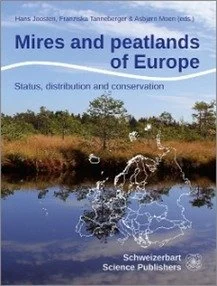Mires and Peatlands of Europe - Status, distribution and conservation
The International Mire Conservation Group (IMCG) has just published a new book - which provides for the first time - a comprehensive and up-to-date overview of the mires and peatlands in biogeographic Europe.
Written by 134 authors, including the Republic of Ireland contribution by Peter Foss and Catherine O’Connell of the IPCC, the book describes mire and peatland types, extent, distribution, use, conservation and restoration individually for each country and integrated for the entire continent. Complemented by a multitude of maps and photographs, the book offers and impressive and colourful journey full of inspiring historical context and fascinating details.
Details:
Mires and peatlands of Europe. Status, distribution and conservation. Edited by Hans Joosten, Franziska Tanneberger & Asbjørn Moen. With contributions of 134 authors. 781 pages, 205 figures, 218 tables, 112 colour photos, 21x28cm, c. 2.5 kg, bound, English. Price: €94.00.
Order your copies directly from the publisher: mail@schweizerbart.de or order on-line from their website
Publishers Synopsis:
This book provides the first comprehensive and up-to-date overview of mires and peatlands in biogeographic Europe. Authored by 134 mire specialists, the extensive volume describes mire and peatland types, terms, extent, distribution, use, conservation, and restoration, individually for each European country and in an integrated manner for the entire continent.
The descriptions are complemented by a multitude of maps and photographs, the book offers an impressive and colourful journey, full of surprising historical context and fascinating details, while appreciating the core principles and unifying concepts of mire science.
The European continent features an impressive variety of mires and peatlands. Polygon, palsa, and aapa mires, concentric and eccentric bogs, spring and percolation fens, coastal marshes, blanket bogs, saline fens, acid, alkaline, nutrient poor, nutrient rich: the peatlands of Europe represent unique ecosystem biodiversity and harbour a large treasure of flora and fauna typical of peat forming environments.
Europe is also the continent with the longest history, the highest intensity, and the largest variety of peatland use, and as a consequence it has the highest proportion of degraded peatlands worldwide. Peatland science and technology developed in parallel to exploitation and it is therefore not surprising that almost all modern peatland terms and concepts originated and matured in Europe.
Their massive degradation also kindled the desire to protect these beautiful landscapes, full of peculiar wildlife. In recent decades attention has widened to include additional vital ecosystem services that natural and restored peatlands provide. Already the first scientific book on peatlands (Schoockius 1658) contained a chapter on restoration. Yet, only now there is a rising awareness of the necessity to conserve and restore mires and peatlands in order to avoid adverse environmental and economic effects.

